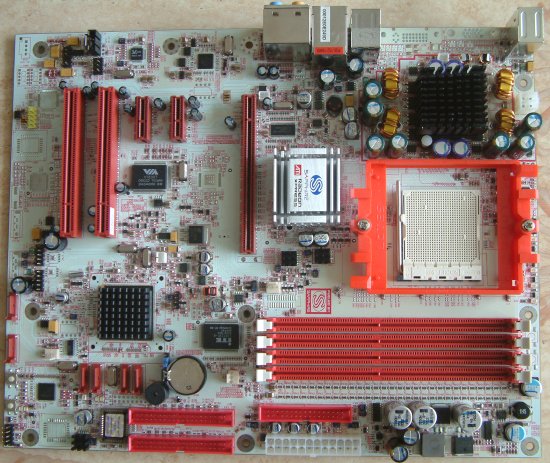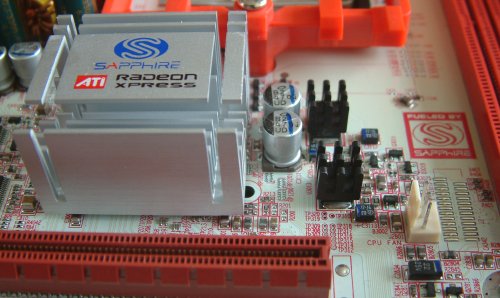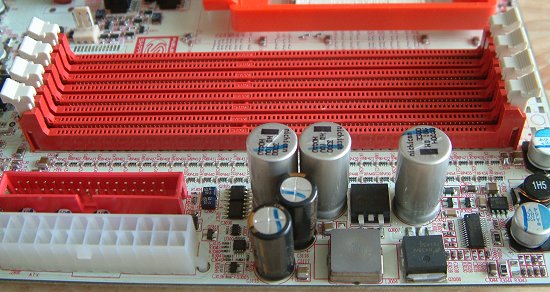Layout and features
Layout and features

If SAPPHIRE's aim was to make a style statement with the PURE, it certainly has. The PCB is reminiscent of Albatron's Silver Shuriken and SOYO's DRAGON series, and the contrast between PCB and port/socket colours has been well-thought out. The back of the board continues the stylish theme, as well. SAPPHIRE recommends not replacing the plastic CPU retention bracket with a metal version, presumably to eliminate any possible short-circuiting.
Apart from the obvious colour choices, the PURE is also different from the norm in a number of other ways.

There's a gaping hole just behind the huge heatsink-clad power-delivery system. Looking at the silkscreened portion, we can safely assume that SAPPHIRE had intended to equip the PURE motherboard with dual VGA/DVI outputs, thereby specifying an IGP-equipped northbridge. It seems as if the SAPPHIRE's had a change of heart but left the PCB unchanged. Note the 4-pin power connector is located close to the power system.

SAPPHIRE, when designing a board for AMD's S939 processors, has not had to spend a deal of time and money in architecting a performance-orientated memory controller hub; AMD's taken care of that with an on-chip controller. What's left is ATI's RX480 northbridge, hidden underneath another passively-cooled heatsink. Indeed, there's no fans present on this enthusiast motherboard, which comes as something of a surprise. The heatsink is close to the CPU retention bracket but installing a larger-than-normal AMD heatsink was no problem at all. The RX480, then, is a GPU-less northbridge that hooks up to the board's PCI-Express lanes, providing a single x16 slot (no CrossFire compatibility on this particular model) and up to 4 x1 lanes, useful for the ever-increasing native PCIe peripherals that are coming to market.

3 huge capacitors sit to the right of the floppy port and main 24-pin power connector. We appreciate the way in which SAPPHIRE has located connectors on the very edge of the board, allowing for a clean physical installation and setup. 4 DRAM slots, DDR1, of course, gives you the usual dual-channel memory architecture that's one of the hallmarks of S939 CPUs. One the face of it, it's strange why SAPPHIRE hasn't colour-coded them, to signify which slots are required for dual-channel mode, but we reckon it's a case of colour style over a little practicality.

Going on to the left, we see another heatsink covering ATI's SB450 southbridge. The 4 on-chip SATA controller, as mentioned, does not support SATA2 and the benefits that arise from it. We'll have to wait for the SB600 before ATI implements it. 2 ATA133 ports are also sensibly positioned at the edge of the board, and ITE 8712F monitoring chip does a reasonable job of voltage reporting.

SAPPHIRE's added in the ubiquitous Silicon Image PCIe-riding 2-port SATA controller, boosting the board's total to 6 ports and adding SATA2 support on the discrete duo. Reviewers and tinkerers will be pleased to see board-mounted power and reset buttons, but we can't see why SAPPHIRE has neglected to label the motherboard-to-case pins. Most manufacturers now use colour-coded pins for easy-as-pie connection. There's space for a second BIOS chip just above, too.
VIA's erstwhile FireWire controller is positioned between the board's two physical PCIe x1 slots. Of the four available on the RX480 chipset, another is taken by the implementation of a Marvell 88E8052 Gigabit Ethernet controller. Just to the right is the single x16 slot, and we'd urge SAPPHIRE to include a card-locking mechanism here, as it's all to easy for heavy cards to become displaced when a case is moved around.
Taking a look at the top-left of the board, we reckon that SAPPHIRE will be launching a super-deluxe version of the PURE board soon. There's PCB markings for a discrete 4-port SATA setup (Sil3134, most likely), a debug LED, much in the vein of ABIT, and, perhaps, another ASIC. What is present, though, is Realtek's ALC 880 8-channel CODEC that's run off the southbridge's integrated Azalia High-Definition Audio.

Just in front of an ICS clock generator is the remnants of the I/O section. 4 USB 2.0 ports, a single FireWire 400, RJ45, and 6 ports for the onboard sound round off this mini section.









